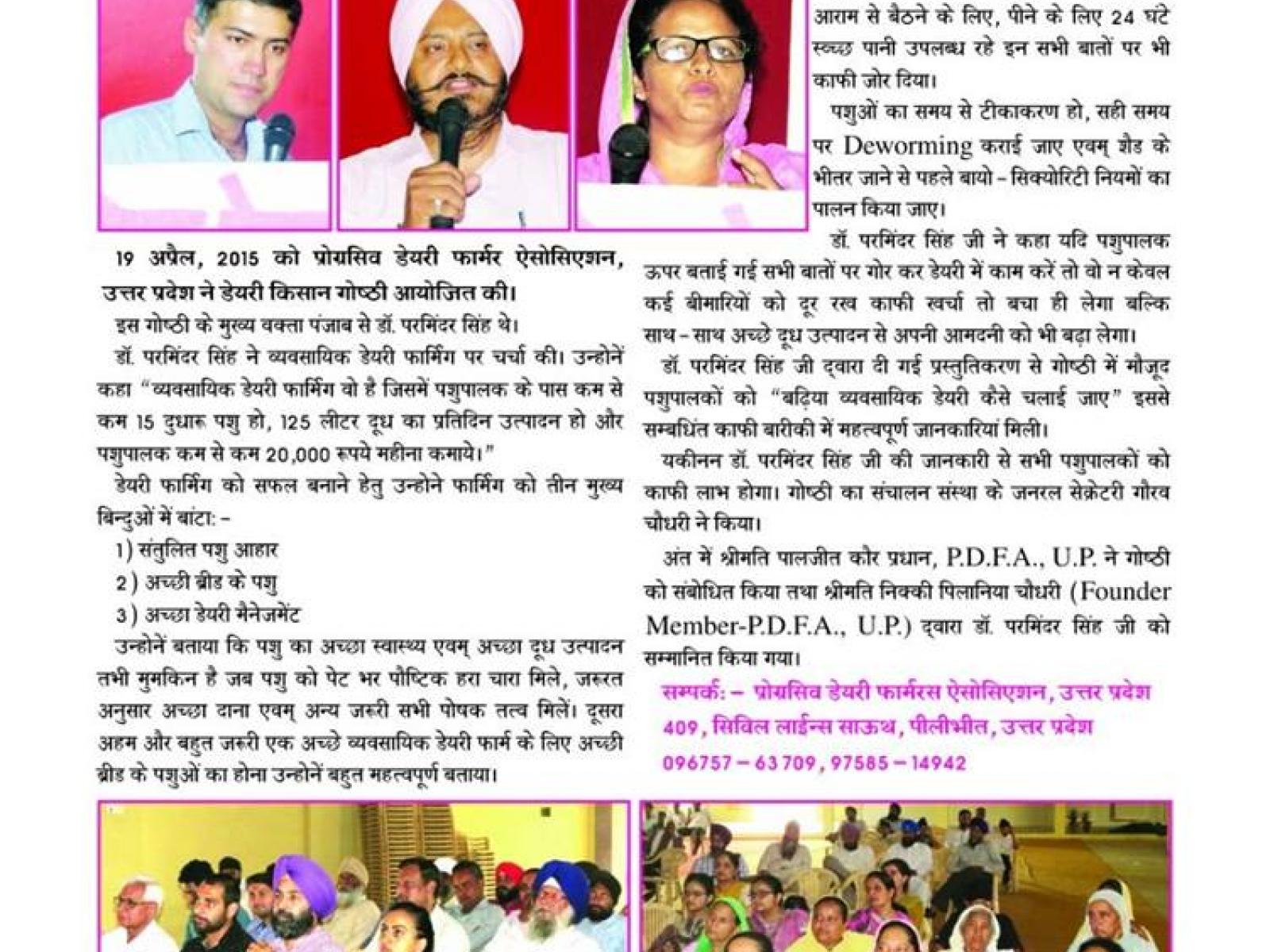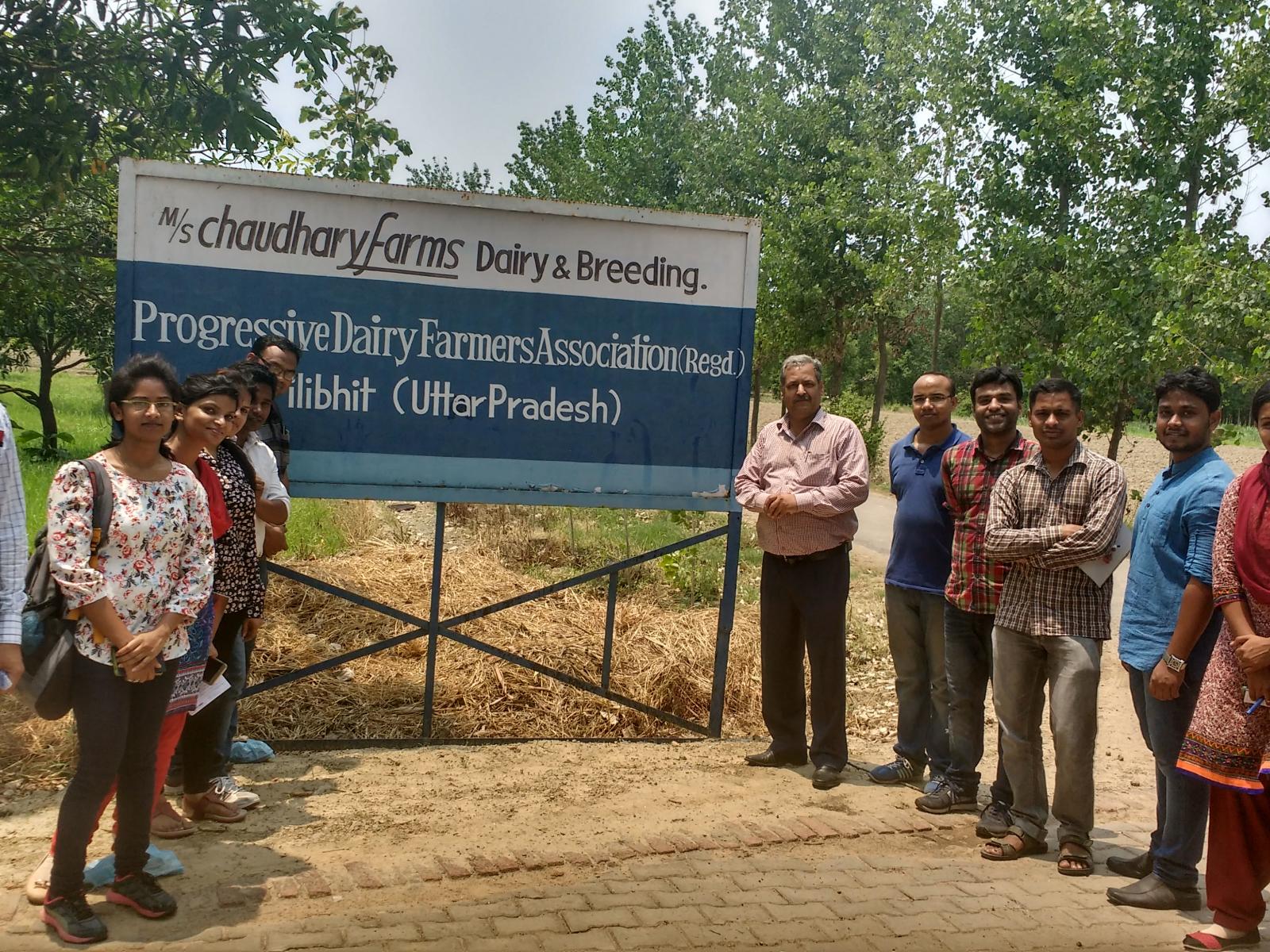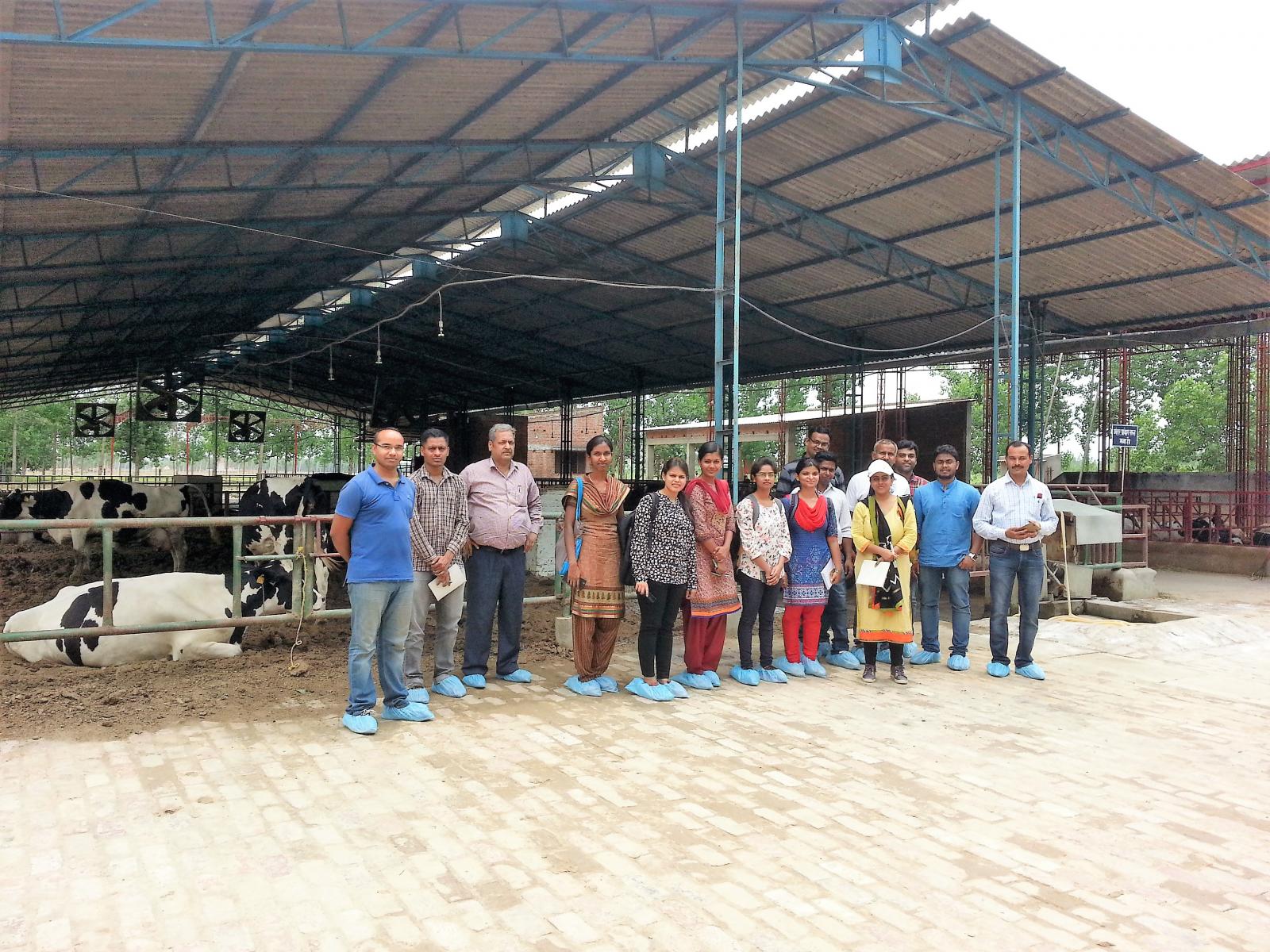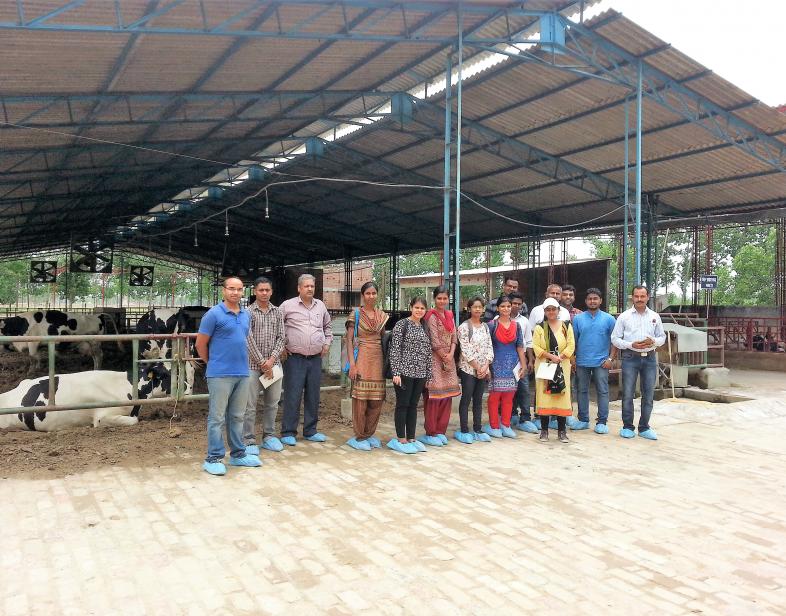An Overview Of Our Solution
India is the World’s largest milk producer but unfortunately this large share in milk comes from the country having world’s largest cattle population of 200 million plus. The productivity per cow in India is just 900 kg per lactation compared to 7000 kg in USA.
Milk Production in India is largely unorganized characterized by poor breed development, poor nutrition to the cows and negligible know how on efficient dairy farming.
Cows excrete enormous methane which is capable of trapping much more heat than CO2 and with such low milk yield per cow the Country has increasing pressure to meet growing demand of milk and milk products of rising population and at the same time reducing GHG emissions.This necessitates improving farmers know how on managing dairy efficiently and this is where we are playing a key role in North Indian state Uttar Pradesh.
- Population Impacted: more than 200
- Continent: Asia
Context Analysis
Currently Indian Dairy is highly fragmented with raw milk production still carried out as a subsistence activity with about 80% milk produced by farmers having just 2 - 4 cattle. Increasing population of unproductive cattle and negligible efforts to aware farmers on developing appropriate Indian-Hf cross breed and efficient dairy management practices is making dairy unsustainable both economically and environmentally. Sourcing and supplying of high quality milk is becoming very costly and challenging for processors and this also threatens the nutritional security of largely vegetarian country India.
Cattle emit highest methane amongst livestock and hence attaining productive efficiency in dairy is the most important factor that farmers’ have within their control to reduce GHG emissions and increase profits. Breed Improvement, maximizing cattle comfort and balanced feed for cows can significantly reduce overall emissions.
Describe the technical solution you wanted the target audience to adopt
We wanted to bridge the major knowledge gap that exists in dairy farming in our state leading to undeveloped dairy & hence higher GHG emissions per litre of milk.
In 2012, we founded Progressive Dairy Farmers Association U.P, to improve farmers interest and knowledge on efficient dairy management. With no modern dairy farm in the region we established a commercial dairy having 60 cattle in 2014 in Village Tanda Vijaisi which provides farmers great exposure on modern dairying.
We are developing and promoting amongst farmers’ appropriate cross of Indian – Hf breed which can give high milk yield and at the same time is climate resilient. We provide Veterinarians, farmers access to the semen of well-bred bulls kept by us to promote breed development in the region backed by guidance on cow nutrition and cow comfort. We have assisted development of several modern dairy farms across U.P which are promoting positive dairy activity in their respective regions
Type of intervention
Describe your behavioral intervention
We facilitated adoption of dairy and higher efficiency in raw milk production in our region through: 1) establishing modern dairy unit with well-equipped milk parlor, comfortable shed, balanced Cross breeds giving wet average of 18 liters throughout the year. The successful dairy farm attracts farmers to take up dairy or expand and run dairy efficiently. The farmers have free access to the dairy and we guide them in detail on scientific dairy practices which has tremendously increased their knowledge, interest and adoption of right practices.
2) Insightful Dairy Farmers Meetings held regularly by industry experts have immensely improved farmers’ knowledge on genetics, cattle diseases & prevention, fodder management etc. We keep semen of elite bulls and provide to farmers/ veterinarians which is promoting breed development. We successfully grow and promote high quality multi-cut fodders such as Rye grass. Along with top cattle nutrition companies we also formulate high quality feed inhouse and supply to farmers at cost effective rates.
So, all the bottlenecks in dairy that existed earlier right from poor know-how on dairy, poor breeds, unavailability of cost effective feed, absence of semen of well-bred bulls and was creating high inefficiencies in dairy and hence negative perception around it has been reduced significantly. About 10 modern dairy farms set under our guidance operate efficiently across our state.
As needed, please explain the type of intervention in more detail
Milk holds a special place for Indian consumers and farmers simultaneously rear cattle as it complements agriculture very well. However dairying continues to be carried in traditional way leading to undeveloped dairy. Emotional Appeals: Setting up of dairy in Village acted very powerfully and positively in igniting the interest and adoption of efficient dairy practices by farmers. Being farmer ourselves we attracted hundreds of farmers at dairy willing to learn and improve their know- how. This has added several modern dairy farms across region with well-bred cows and these farmers are marketing their farm fresh milk amongst consumers.
Social Incentives: We promote good dairy practices and publicise good work in Farmer meetings. We also promote dairy on various Social Media channels which attracts lot of attention and interest
Describe your implementation
Setting up of highly efficient dairy farm in deep interiors of U.P attracts farmers on daily basis who seek guidance on how they can run dairy viably. Learning practically from dairy gives them deep insights, positive experience and encourages quick learning on need of balanced breeds, comfortable shed and balanced nutrition.This has significantly improved productive efficiency and breed development at dairy farms reducing the burden on finite sources such as land, fodder, feed, electricity. The milk yield per cattle on farms has more than doubled and input costs have gone down by around 30 percent. This means farmers are now taking more milk from lesser cows at lower costs.
We have completely changed the trend on many things in dairy: many upcoming farms in Uttar Pradesh are buying dairy cattle from us to expand on good breeds and several farms now have well-bred cows which are expanding very fast in the region. Farmers are clear on breeding strategy of having cross of Indian- Hf in ratio of (1/2,1/2) or ( 3/8,5/8). With insights into right nutrition practices the farmers are saving about 25 percent cost of raw milk production. We also train farmers on making maize silage, right deworming, vaccination practices and most importantly maintaining healthy rumen of cows and preventing mastitis. All this has significantly reduced medical expenses of farmers on cattle diseases by upto 30 percent.
Since our state U.P had no modern commercial dairy farm, we had to spend three years on rigorous research on dairy and we travelled frequently to two progressive states of Haryana ,Punjab to gain insights from expert dairy farmers. There was a problem of getting semen of well bred bulls , high quality cattle feed at reasonable prices. We tied up with ABS-Global and nutrition companies and now maintain these facilities within dairy premises which is helping several other farmers in getting access to extremely important inputs in successful dairying.
External connections
The Progressive dairy farmers of adjoining states Haryana and Punjab which have India’s most developed Dairy farms and appropriate cross breeds were of tremendous help in the journey to bring all dairy know- how in our state Uttar Pradesh. We are member of Progressive Dairy Farmers Association of Punjab since 2011 and inspired by that we initiated Dairy Association in our state in 2012.
The farmers of our state collectively took interest in adopting modern dairy practices and due to their growing interest we could attract several best dairy cattle nutrition, genetics experts to give key information on the various aspects of efficient raw milk production.
The companies closely working with us are ABS Global, Cargill Feeds under whose assistance we have been able to bring best dairy practices in our region.
We have participated at various forums such as World Forestry Congress-2015 , Global Forum for Agricultural Research- 2016 and Emerging Technologies for Food Security-2018 to present our insights into Indian Dairy with Policy makers, farmers, scientists.
Our research on Indian Gir cattle is facilitated by GFAR-2016 which is a superior milch yielding cattle but undeveloped in India.
Who adopted the desired behaviors and to what degree?
Several Farmers (approx. 200) in our state Uttar Pradesh upon visiting Chaudhary Farms Dairy realized importance of having good breeds, comfortable housing and balanced nutrition to run a sustainable and profitable dairy Farm. About 50 farmers buy semen of well- bred bulls from us for breed development alongwith cattle feed prepared by us to optimize feed costs.
Farmers are increasingly adopting all standard operating practices in dairy to be efficient such as timely deworming, vaccination maintaing record of herd to take informed decisions. Many farmers in regular interaction with us report improved efficiency gains in dairy.
We also provide dairy tour to agriculture and veterinary students to give them practical insights into modern efficient dairy. https://blog.gfar.net/2016/05/26/a-day-out-at-nikkis-farm-a-youth-agrip… write blogs on dairy and participate in Dairy Conferences to put forth experience as a dairy farmer and bring in positive change.
How did you impact natural resource use and greenhouse gas emissions?
We have positively added and facilitated productive efficiency in dairy key factor to reducing carbon footprint using following: 1) Adopting and encouraging appropriate cross breeds capable of giving high milk and at the same time are climate/disease resillient.
2) Introducing high quality multi -cut fodders such as Rye grass that also grows very well under poplar tress encouraging agroforestry.
3) Providing cost effective digestible feeds to farmers reducing rumen fermentation.
4) All this has positively contributed to higher milk yield cost effectively which means much lower methane emission per litre of milk and proper utilization of resources.
5) The manure is used in field reducing the need for synthetic fertilisers by about 10 percent saving input costs and naturally improving soil.
https://forests2015.wordpress.com/2015/06/03/integrating-poplar-based-a…
What were some of the resulting co-benefits?
The improved awareness of farmers on dairy in our state due to setting up of a model dairy farm and Progressive dairy farmers association has strengthened dairy in Uttar Pradesh positively contributing to farmers’ economic returns as well as improved environmental benefits. Improved breed development is taking place which ensures more milk, multiple lactations and higher disease and climate resilience reducing wasteful expenditures/ resources on maintaining unproductive cattle.
Introduction of much higher quality fodders such as rye grass giving up to 6 cuttings has significantly reduced cost on fodder operations and ensure very high yield per acre of land. Rye grass along with fodder oats gives good yield in Poplar block plantations also facilitating agroforestry system of land use.
Our 60 cow dairy unit provides employment to 10 people and setting up of other such dairy farms are generating employment and developing dairy skills amongst others as well.
Sustainability
Efficiency is the key in attaining profitability and sustainability in dairy farming. It is a knowledge intensive sector and we facilitate knowledge dissemination to ensure farmers gain efficiency in dairy which has the most potential to reduce GHG emissions substantially.
Being farmer ourselves and involved in farming, dairy and agribusiness we are connected with more than 5000 farmers in our State and hence dairy set up attracts hundreds of farmers.Our solution is self sustainable. Initially to gather know-how , registering and conducting Progressive dairy farmers association/meetings we incurred costs but now this continuous process of knowledge dissemination is developing the overall Dairy in our state.
Return on investment
Dairy Farming in our State was completely backward with no single modern dairy farm. There was no place where farmers could get guidance on dairy and there was no presence of good animal genetics, cattle nutrition companies here.
To change the scenario, we formed Dairy Association in 2012 and conducted meetings quarterly on dairy initially using our capital and now sponsored by companies. But the major change came on setting up of modern dairy in village which is emerging a learning source for farmers.Our main investment was on gathering information & rigorous research we did on dairy by visiting progressive dairy states.
The knowledge dissemination has tremendously improved dairy farming in our state.
How could we successfully replicate this solution elsewhere?
The solution can be easily replicated as it is based on knowledge dissemination on efficient dairy practices amongst farmers.
The guidance from farmers/entrepreneurs running good dairy farms encourages others to learn and adopt the right practices significantly.
We initiated the effort in our state Uttar Pradesh by setting up of modern dairy unit which attracted hundreds of farmers keen to produce milk efficiently.This has helped set up of 10 modern dairy farms across state in a short period of 4 years which are becoming learning centers too.
The knowledge on appropriate cross- breeding, importance of giving right nutrition- fodder/ feed and ensuring comfortable and hygienic environment to cows maximize productive efficiency of dairy farms to meet dual goal of raising farm profitability and mitigating greenhouse gas emissions, is spreading very fast in our state now.




